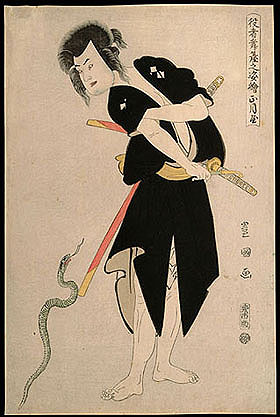|
Buncho and Shunsho had already set
the precedent for more dramatic emphasis in portraying the
Kabuki actor. Toyokuni, at 15, was still a student when Kiyonaga
was creating his great series of triptychs and diptychs depicting
the young men and women of Edo's demimonde, and at 20 he saw
the first bust portraits of actors appear under the signature
of Shunsho's two main pupils Shun'ei and Shunko. Endowed with
great vigor and ambition, and with a genuine respect for the
printmakers working around him in the late 1780's, Toyokuni
began producing bijin-ga (pictures of beautiful women) in
the manner of Kiyonaga and Utamaro. His prints of this period
clearly exhibit the attenuated figures made famous by these
masters. It is tempting to speculate, as many writers have,
why Toyokuni chose to follow the style of others in his early
work. Some have claimed that he had no original talent. I
would proffer the view that he was satisfied to follow in
order to gain experience. I can imagine few artists in any
time or tradition that do not owe a debt to the labors and
talents of other artists working in their milieu.

illustration 2
|
 |
In 1792, when Toyokuni was continuing
to produce portraits of beautiful women of the Yoshiwara and
views of their environs, Shunsho died leaving the whole field
of actor prints largely unattended. Seventeen ninety-four
was a momentous year. The great Sharaku appeared on the scene
and, in the space of a year, produced an array of actor prints
profoundly different from anything seen before or since. At
the end of that year, he disappeared as mysteriously as he
had come.
Toyokuni turned his attention to designing
actor prints. He formed a fortunate alliance with Izumiya
Ichibei, the publisher of many of Utamaro's bust portraits
and some of Eishi's finest triptychs. Ichibei published Toyokuni's
prints for roughly the next decade, which was the period of
the artist's finest work. The famous series Yakusha Butai
no Sugata-e (Views of Actors on Stage) which was to be Toyokuni's
most extensive production, and which contained many minor
masterpieces, was begun in the early months of 1794. One of
the most admired designs of this series is a stately figure
of Sawamura Sojuro III, who was famous in his day as a tragic
actor (sheet number two of a pentaptych, the only one Toyokuni
designed). He is shown as a samurai in the guise of a wandering
komuso with his straw hat and fan, in the play Keisei Sambon
Karakasa which was performed at the Miyako-za in the 7th month
of that year. 1. (see illustration 1) Another design from
the same series, the center sheet of a triptych, shows the
actor Sakata Hangoro III as Fujikawa Mizuemon with a snake,
in the play Hanayame Bunroku Soga, performed at the Miyako-za
in the spring of 1794. Hangoro, playing the part of the villain
in the play, has an obsessed expression on his face, and the
snake is indicative of his state of mind. With Hangoro's mask
like face, Toyokuni came closer to a psychological portrait
than even the great Sharaku. The folds of the actors black
garment were printed by burnishing, and the gray ground is
overlaid with a soft white mica. (see illustration 2) The
virtues of this series have been extolled by many writers
including James A. Michener, who said that once this series
is finally cataloged, it may number as many as 50 separate
subjects.
(Click
here to continue)
|


